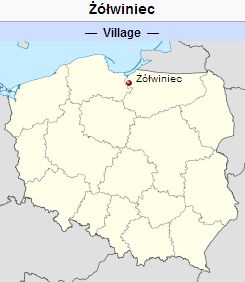Difference between revisions of "Wengelwalde (Warmian-Masurian Voivodeship, Poland)"
| [checked revision] | [checked revision] |
m (Added categories.) |
SusanHuebert (talk | contribs) m |
||
| (2 intermediate revisions by one other user not shown) | |||
| Line 1: | Line 1: | ||
| − | [[File:Wengelwalde.jpg|300px|thumb|right|'''']] | + | [[File:Wengelwalde.jpg|300px|thumb|right|''Wengelwalde (now Żółwiniec, Poland<br /> |
| − | [[File:Wengelwalde%20detailed%20map.jpg|300px|thumb| | + | Source: [https://en.wikipedia.org/wiki/%C5%BB%C3%B3%C5%82winiec,_Warmian-Masurian_Voivodeship Wikipedia Commons]'']] |
| + | [[File:Wengelwalde%20detailed%20map.jpg|300px|thumb|left|''Detailed map of Wengelwalde, 1930<br /> | ||
Source: [http://kpbc.umk.pl/dlibra/doccontent Kujawsko-Pomorska Biblioteka Cyfrowa]'']] | Source: [http://kpbc.umk.pl/dlibra/doccontent Kujawsko-Pomorska Biblioteka Cyfrowa]'']] | ||
| − | Wengelwalde (also known as Wengelnwalde and Wiebenwald; now known as Żółwiniec; coordinates: 54.0754, 19.4311 [54° 4′ 31″ N, 19° 25′ 51″ E]; population in 1905, 281; in 2013, 80) is located approximately 10.5 kilometers (6.5 miles) | + | Wengelwalde (also known as Wengelnwalde and Wiebenwald; now known as Żółwiniec; coordinates: 54.0754, 19.4311 [54° 4′ 31″ N, 19° 25′ 51″ E]; population in 1905, 281; in 2013, 80) is located approximately 10.5 kilometers (6.5 miles) southeast of Elbląg ([[Elbing (Warmian-Masurian Voivodeship, Poland)|Elbing]]), 25 km (16 miles) east of Malbork ([[Marienburg (Pomeranian Voivodeship, Poland)|Marienburg]]), and 26 km (16 miles) south-east of Nowy Dwór Gdański ([[Tiegenhof (Pomeranian Voivodeship, Poland)|Tiegenhof]]). It was situated to the east of [[Hohenwalde (Warmian-Masurian Voivodeship, Poland)|Hohenwalde]]. |
Wengelwalde was established in 1678. Until 1772 Wengelwalde was located in what was known as Royal Prussia (also known as Polish Prussia) in the Kingdom of Poland. The First Partition of [[Poland|Poland]] in 1772 resulted in the creation of a new province in 1773, called [[West Prussia|West Prussia]], in which Wengelwalde was located. Wengelwalde was situated in the district (Kreis) of Marienburg until the end of World War I, when it came under the jurisdiction of the German province of East Prussia. At the outbreak of World War II in 1939, it came under the control of Nazi Germany. In February 1945 it was occupied by Soviet forces and eventually returned to Poland. In 2012 Żółwiniec was a village in the administrative district of Gmina Markusy, within Elbląg County, Warmian-Masurian Voivodeship. | Wengelwalde was established in 1678. Until 1772 Wengelwalde was located in what was known as Royal Prussia (also known as Polish Prussia) in the Kingdom of Poland. The First Partition of [[Poland|Poland]] in 1772 resulted in the creation of a new province in 1773, called [[West Prussia|West Prussia]], in which Wengelwalde was located. Wengelwalde was situated in the district (Kreis) of Marienburg until the end of World War I, when it came under the jurisdiction of the German province of East Prussia. At the outbreak of World War II in 1939, it came under the control of Nazi Germany. In February 1945 it was occupied by Soviet forces and eventually returned to Poland. In 2012 Żółwiniec was a village in the administrative district of Gmina Markusy, within Elbląg County, Warmian-Masurian Voivodeship. | ||
| − | The | + | The Prussian census of 1776 lists 29 Mennonite families with 96 individuals, with the following surnames: Bestvader, Brandt, Butthwig, Dau, Engbrecht, Frantz, Froese, Jantzen, Kliewert, Kneiphoff, Martens, Penner, Peters, Schaeffer, Schmidt, and Stob. In 1820, the village had 267 residents, including 114 Mennonites, while in 1885 - 477 ha, 61 houses, and 325 residents, including 51 Mennonites. |
Mennonites who were residents of Wengelwalde were members of the [[Thiensdorf and Preußisch Rosengart Mennonite Church (Warmian-Masurian Voivodeship, Poland)|Thiensdorf]]-Markushof Mennonite Church. | Mennonites who were residents of Wengelwalde were members of the [[Thiensdorf and Preußisch Rosengart Mennonite Church (Warmian-Masurian Voivodeship, Poland)|Thiensdorf]]-Markushof Mennonite Church. | ||
Revision as of 17:16, 3 August 2016
Wengelwalde (also known as Wengelnwalde and Wiebenwald; now known as Żółwiniec; coordinates: 54.0754, 19.4311 [54° 4′ 31″ N, 19° 25′ 51″ E]; population in 1905, 281; in 2013, 80) is located approximately 10.5 kilometers (6.5 miles) southeast of Elbląg (Elbing), 25 km (16 miles) east of Malbork (Marienburg), and 26 km (16 miles) south-east of Nowy Dwór Gdański (Tiegenhof). It was situated to the east of Hohenwalde.
Wengelwalde was established in 1678. Until 1772 Wengelwalde was located in what was known as Royal Prussia (also known as Polish Prussia) in the Kingdom of Poland. The First Partition of Poland in 1772 resulted in the creation of a new province in 1773, called West Prussia, in which Wengelwalde was located. Wengelwalde was situated in the district (Kreis) of Marienburg until the end of World War I, when it came under the jurisdiction of the German province of East Prussia. At the outbreak of World War II in 1939, it came under the control of Nazi Germany. In February 1945 it was occupied by Soviet forces and eventually returned to Poland. In 2012 Żółwiniec was a village in the administrative district of Gmina Markusy, within Elbląg County, Warmian-Masurian Voivodeship.
The Prussian census of 1776 lists 29 Mennonite families with 96 individuals, with the following surnames: Bestvader, Brandt, Butthwig, Dau, Engbrecht, Frantz, Froese, Jantzen, Kliewert, Kneiphoff, Martens, Penner, Peters, Schaeffer, Schmidt, and Stob. In 1820, the village had 267 residents, including 114 Mennonites, while in 1885 - 477 ha, 61 houses, and 325 residents, including 51 Mennonites.
Mennonites who were residents of Wengelwalde were members of the Thiensdorf-Markushof Mennonite Church.
Bibliography
Stowarzyszenie Konserwatorów Zabytków. "Żółwieniec (Żółwiniec)." Catalogue of Monuments of Dutch Colonization in Poland. 2005. Web. 17 February 2013. http://holland.org.pl/art.php?kat=obiekt&id=483&lang=en.
Wikipedia. "Żółwiniec, Warmian-Masurian Voivodeship." Web. 17 February 2013. http://en.wikipedia.org/wiki/Żółwiniec,_Warmian-Masurian_Voivodeship.
Wolf, Hans-Jürgen. "Familienforschung in Westpreußen." Web. 12 February 2013. http://www.westpreussen.de/cms/ct/ortsverzeichnis/details.php?ID=6860.
Maps
Map:Żółwiniec, Warmian-Masurian Voivodeship, Poland
| Author(s) | Richard D Thiessen |
|---|---|
| Date Published | February 2013 |
Cite This Article
MLA style
Thiessen, Richard D. "Wengelwalde (Warmian-Masurian Voivodeship, Poland)." Global Anabaptist Mennonite Encyclopedia Online. February 2013. Web. 23 Apr 2024. https://gameo.org/index.php?title=Wengelwalde_(Warmian-Masurian_Voivodeship,_Poland)&oldid=135401.
APA style
Thiessen, Richard D. (February 2013). Wengelwalde (Warmian-Masurian Voivodeship, Poland). Global Anabaptist Mennonite Encyclopedia Online. Retrieved 23 April 2024, from https://gameo.org/index.php?title=Wengelwalde_(Warmian-Masurian_Voivodeship,_Poland)&oldid=135401.
©1996-2024 by the Global Anabaptist Mennonite Encyclopedia Online. All rights reserved.

